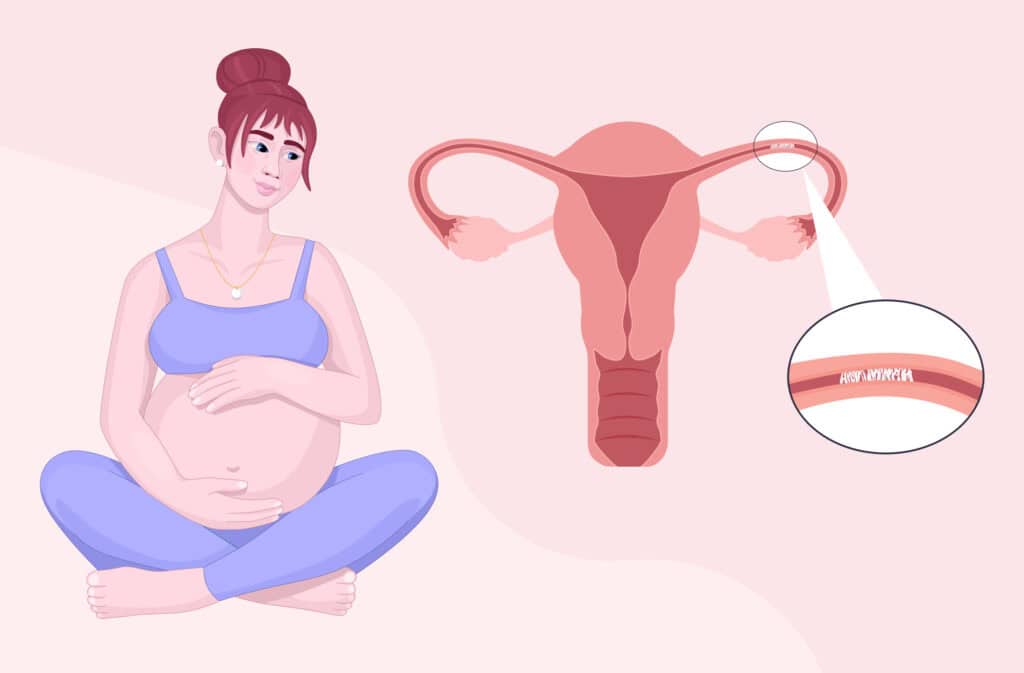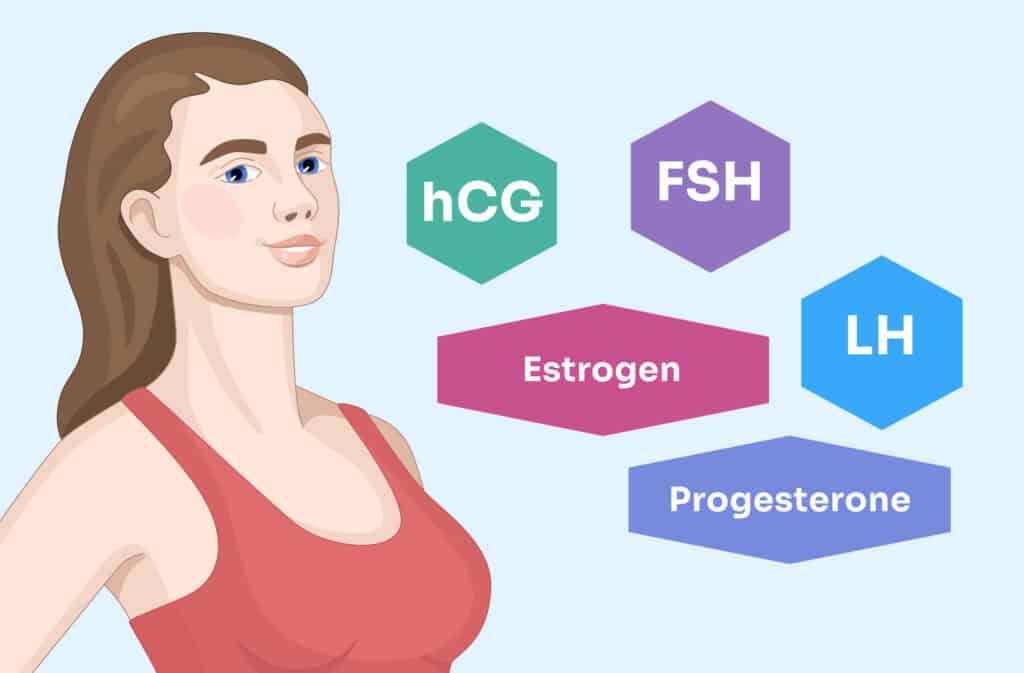Femia > Health Library > Being a mom > Recovering from birth > The 5-5-5 postpartum recovery: What it is and how it helps
The 5-5-5 postpartum recovery: What it is and how it helps

- Updated Feb 11, 2025
- Published
CRAFTED BY HUMAN
Crafted by human At Femia, we provide accurate and up-to-date information at every stage of your journey, from trying to conceive, pregnancy and postnatal support. All content is created by a real person based on in-depth research and own professional experience. Femia ensures that you will receive expert advice, strict accuracy and a personalized approach from our authors/medical experts. Learn more about our editorial policy.
FACT CHECKED
Fact checked At Femia Health, we maintain the highest standards of editorial excellence in delivering content focused on helping you conceive, guiding you through pregnancy, and supporting you postpartum. Explore our content review principles to learn how we ensure the accuracy and quality of our health and lifestyle tips for every stage of your journey.
- The 5-5-5 rule after birth is a recovery guideline that focuses on achieving rest and recovery while bonding with your baby.
- Soon after delivery, your hormone levels significantly decrease, making the postpartum period a difficult time for managing your emotions while simultaneously dealing with your physical recovery.
- The 5-5-5 rule allows for incremental, actionable steps you can take while resting on your bed to slowly reengage some activities during the postpartum healing phase.
As much as you may have prepared for your postpartum recovery, once you arrive home with your baby, it may still feel like something is missing.
Many people don’t foresee the physical and emotional challenges that they experience in addition to the joy of bringing home their newborns.
The simple 5-5-5 rule after birth enables you to recover safely while undertaking the initial phase of bonding with your baby. In this article we will look through what the 5-5-5 rule is, how it fosters safe postpartum recovery, and other tips to help you in the postpartum period.
Femia offers personalized insights and helps you stay in control
What is the 5-5-5 rule for postpartum?
The 5-5-5 rule postpartum is made to follow three simple steps for recovery in the first 15 days after childbirth. These steps include:
- 5 days in bed
- 5 days on the bed
- 5 days around the bed
While the first two steps may appear similar, we will shortly see the differences in what activities are permissible and what are not during these days of postpartum healing. The 5-5-5 rule is simple to remember, but crucial to follow because it paves the way for adequate healing.
New mothers are encouraged to follow the 5-5-5 rule – which includes not taking up tasks around the house – helping to ensure a safe recovery. The rule should also motivate new mothers to ask for help when required, reducing the strain on them in the first couple of weeks.
👉Find out more: Signs of ovulation after giving birth: What new moms need to know
Why is the 5-5-5 rule important for postpartum recovery?
Following the 5-5-5 rule after birth means setting aside time in the first 15 days after giving birth only for recovery and bonding with the newborn:
- The mandatory 5-5-5 rule postpartum permits you to ignore everything else going on around you. You and your baby are your prime focus during these 15 days postpartum.
- This intentional rest encourages you to understand what your physical and mental health requirements are during postpartum healing.
- While bonding with your baby, you’ll become aware of how often your baby feeds and any struggles they have with feeding, while also taking the time to welcome a new person in your life.
- Following through with the 5-5-5 rule immediately puts you at a lower risk for postpartum bleeding and infections. Resting during this period helps reduce the risk of mechanical injuries and bleeding, as it allows the pelvic organs and uterus to recover. Monitor for signs of infection, such as fever, heavy bleeding, or chills, and seek medical attention if needed.
- Focusing on yourself allows you to also notice worrying postpartum symptoms, such as postpartum dizziness or increased swelling in your feet, which may require medical care.
How do you implement the 5-5-5 rule postpartum rule?
As we have seen above, you will be spending 5 days “in” bed, 5 days “on” your bed, and 5 days “around” your bed. These 15 days of postpartum healing are only a start, and not the end of your postpartum rest.
It will take a few months for your body to recover physically, but hormonal and emotional adjustments may take longer, especially if you are breastfeeding. The changes in your body, including the healing of your C-section scar and the return to your normal routine, can be affected by your emotional state and hormone fluctuations.
Be patient with yourself during this time, as both your body and mind need time to heal and adjust to the new demands of motherhood. The postpartum 5-5-5 rule is meant to provide complete rest. It encourages you to recognize that postpartum healing takes time and that you should listen to how your body is doing.
In the next few sections, we will see how you can follow these steps.
5 days in bed
In the first 5 days postpartum, you are probably exhausted from childbirth and also coping with the emotional challenges brought about by the sudden drop in your pregnancy hormones. This should make the first few days easy to follow through on the rule to simply lie in bed. Try to get as much sleep and rest as you can. Only get up when you have to use the bathroom or freshen up.
You can prepare for your first 5 days before delivery by setting up everything that you’ll need around your bed. This can include items such as diapers, a bassinet, and personal items. Ideally, you can have your postpartum helpers bring in your meals when you are ready for them. During this time you should also focus on your baby’s feeding patterns, especially if you are breastfeeding.
If you encounter feeding issues, you can bring them up at your next postnatal check-in.
5 days on the bed
For the next 5 days on your bed, you continue focusing on rest, recovery, and bonding – but with some slight changes.
You can sit up now versus just lying down, as you did during the first five days. You should continue bonding, skin-to-skin, and breastfeeding (if you have chosen to) during these five days. You can sit up and entertain visitors who have been waiting to see you. If you have older children, you can do some light activities such as reading to them. In short, these 5 days postpartum, your activities can become a little more involved, but you should still be in bed.
5 days around the bed
For the final 5 days postpartum you can move around your room for a little while every day. This marks your transition from your bed to other parts of your home. However, you’re still not ready to go full throttle.
During this time, light activity such as short walks around the room or gentle stretching exercises can promote blood circulation and help prevent deep vein thrombosis, especially for those recovering from a C-section. These activities support overall recovery by reducing the risk of blood clots and improving mobility as your body heals.
You can sit in locations other than your bed. But all the while, you’re continuing to rest, lie down when tired, and take frequent naps. You can do light activities such as folding the laundry or washing a dish or two. But really restrict your activities. As a rule, you don’t stand for more than 20-30 minutes at a time.
Femia offers personalized insights and helps you stay in control
Postpartum recovery timeline
Your postpartum phase begins right after delivery. It ideally lasts for 6 weeks – the period when most of your recovery takes place. This can, however, extend up to 6 months. During this time your body and mind will go through significant changes, attempting to recover from both pregnancy and delivery.
The type of delivery you had, your health during pregnancy, and any complications after delivery can all affect postpartum healing.
1 - 2 weeks postpartum
You will be following the postpartum 5-5-5 rule to help you through the first two weeks after birth. Most of your body will feel sore, especially your pelvic and genital regions, which face the brunt of delivery. Your doctor can guide you on steps you can take during recovery to ease the pain and reduce the soreness.
During the first two weeks, you will also be advised to watch for signs of infection, such as high fever, or chills. You may have moderate bleeding in the first week, which should subside by the end of the week. In week two, you will likely continue to have pinkish-brown discharge.
6 weeks postpartum
By week 6, your uterus should have shrunk back to its pre-pregnancy size. You will likely continue to have vaginal discharge, called lochia, for up to six weeks. The discharge color is usually yellowish-white, with no blood. If you are still heavily bleeding, consider talking to your healthcare provider.
Six weeks postpartum is usually a big milestone, as you are usually given the all-clear for more activities such as jogging, doing some light lifting, and sex. Although you are permitted to do more things, continue taking frequent breaks, as your body is still undergoing postpartum healing. Additionally, if you are breastfeeding, you may experience more fatigue, so fuel your body adequately.
6 months postpartum
Most of the hormonal shifts you experienced in the first month or so – which may have included emotion swings, hair loss, and heavy fatigue – should have subsided now. Another win at six months is the full return of your bladder control. Your periods may also commence, perhaps with some delay if you are breastfeeding. By month six postpartum, you will have a lot of your energy and be almost ready to return to most of your pre-pregnancy activities.
However, during this phase of postpartum recovery, it is important to be mindful of hormone fluctuations and attendant symptoms such as postpartum dizziness, fatigue, extreme moodiness, or decreased libido. This often warrants a visit to the doctor.
👉Find out more: A complete guide to postpartum sex: What to expect and how to prepare
Postpartum mental health: Why rest matters
Nearly 50% of new moms experience something known as “baby blues” during postpartum healing. This entails feelings of sadness, irritability, and anxiety over becoming a new mother. It may be reassuring to know that the baby blues is not typically severe and usually subsides on its own.
As long as these emotions don’t affect how you bond with your baby, and you feel well enough to take part in your daily activities there’s no cause for concern. If you find yourself feeling withdrawn and lacking enthusiasm for activities involving your baby, check in with your doctor.
Approximately 17% of the world’s population suffers from serious postpartum depression.
Starting with the postpartum 5-5-5 rule can help you assess your physical and mental well-being early. Do not hesitate to check in with your doctor before a scheduled postnatal visit for recovery advice and help.
Common challenges with the 5-5-5 rule and how to overcome them
Prioritizing rest and recovery soon after delivery can be difficult. A few challenges when trying to implement the 5-5-5 rule for postpartum healing include:
- You may not have all the essentials to follow the 5-5-5 rule immediately after delivery. Try as best you can to prepare things before the delivery, and ask for help where required.
- The immediate pressures to “bounce back” after delivery can make following through with the 5-5-5 rule difficult.
- While the postpartum 5-5-5 rule is only 15 days long, it takes a minimum of six weeks to feel a little bit like your pre-pregnancy self again. Recover doesn’t end at 15 days, it takes much longer.
- 15 days may seem to arrive too soon with you feeling it wasn’t enough rest. In this case, there is no harm in extending your rest period.
Every woman’s recovery timeline after delivery is different. If you feel that you’re having difficulty recovering, consult with your healthcare provider for individualized care.
Tips for postpartum recovery beyond the 5-5-5 rule
Regardless of whether you had a vaginal birth or C-section delivery, you will have to allow yourself sufficient time to heal beyond the 5-5-5 postpartum rule. You will require some tailored postpartum essentials – things like ice packs and belly wraps to help you heal.
Additional tips for postpartum recovery include:
- Soon after recovery, ensure you are sufficiently hydrated. From losing a significant amount of blood, to starting with breastfeeding, as a new mother it is relatively easy to become dehydrated. Aim for 16 cups of water, or 2.5 – 3 L daily.
- Prioritize your rest. It is easy to get lost in all your newborn’s requirements, but without a rested mother, your baby will not get the optimum care they deserve.
- Your hormones are going to experience a drastic shift in the next week or so. While it can take a few months for your hormones to balance themselves out, you can start with some simple routine habits to promote a natural shift in your hormones.
- While you may not be able to start your usual workout routine, you can opt for walking and simple movement routines after you complete your 5-5-5 postpartum recovery plan.
- Following some mindfulness techniques – such as mindful breathing, meditation or light yoga – can help with postpartum healing. These kinds of techniques have been shown to improve well-being and even postpartum depression symptoms.
- Consider joining a postpartum support group. Many mothers experience issues that don’t quite warrant a doctor’s visit. For this, there are support groups. Often other moms have found solutions for problems that are new to you.
When to seek medical help during postpartum recovery
Depending on your delivery you may go home within a few days or a week after giving birth. During this time, your doctor should provide you with basic guidelines on how to care for yourself during your postpartum recovery.
Ideally, your first postnatal visit is 6 weeks after delivery. However, you should get a medical check-up before that if:
- You notice any signs of infection such as pain, fever, or chills
- You have a severe headache or experience blurred vision
- You have swelling in your legs
- Your postpartum bleeding is heavy or with clots, and doesn’t reduce in a few days
- You experience significant emotional distress and are unable to bond with your baby
Questions from the Femia community
Does the 5-5-5 rule apply if I had a C-section delivery?
Yes, you can apply the 5-5-5 postpartum rule even after a C-section. With the incision wound healing, and the soreness from delivery, taking rest and allowing your body to heal is crucial after a C-section.
Can I follow the 5-5-5 rule if I have other children to look after?
Most definitely! The first 5 days postpartum require you to just take time for yourself and your new baby. Your partner and other friends have to help with your other children during this time. For the next 5 days, you can sit in bed and read to your other children or talk to them for some parts of the day.
What happens if I don’t follow the 5-5-5 rule?
Rest leads to recovery. If you do not allow yourself complete rest for two weeks, you may observe a delay in your postpartum healing. It might also worsen bleeding, cause fatigue, and affect healing.
Does the 5-5-5 rule mean I can’t leave the house for 15 days?
Not if it is necessary. It is ideal for the first two weeks after delivery that you take complete rest. You will also soon realize that you need it, especially with the fatigue from the process of delivery and the soreness your body is experiencing. That being said, if you have to, you can attend to requirements outside your home.
What if I feel ready to do more than is advised before the 15 days is up?
It is best to just wait it out for 15 days and allow your body to recover. You may feel great by the end of the first week, which is why the 5-5-5 rule allows you some movement within 5 days postpartum, increasing it further 5 days after that. By day 15 you should be ready to take on more tasks and also assess how you feel in terms of energy, and healing progress.
The bottom line
The postpartum 5-5-5 rule is a simple and effective way for you to start your postpartum recovery. The first 5 days involve lying in bed. This is followed by 5 days of simple activities such as sitting up and doing light activities while still on your bed. The final 5 days postpartum are for you to move around your bed, but still within your home.
This simple framework ensures you prioritize rest and recovery soon after delivery. This is especially important as your body feels sore soon after birth. Complete rest also allows you to understand how your body is recovering and to recognize the state of your physical and mental health, and assess whether you need additional medical care.
References
- Romano, Mattea, et al. Postpartum Period: Three Distinct but Continuous Phases. 1 June 2010, pmc.ncbi.nlm.nih.gov/articles/PMC3279173.
- Sherman, Dan, et al. “Characteristics of Normal Lochia.” American Journal of Perinatology, vol. 16, no. 08, Aug. 1999, pp. 0399–402. https://doi.org/10.1055/s-1999-6818.
- Balaram, Kripa, and Raman Marwaha. “Postpartum Blues.” StatPearls – NCBI Bookshelf, 6 Mar. 2023, www.ncbi.nlm.nih.gov/books/NBK554546.
- Wang, Ziyi, et al. “Mapping Global Prevalence of Depression Among Postpartum Women.” Translational Psychiatry, vol. 11, no. 1, Oct. 2021, https://doi.org/10.1038/s41398-021-01663-6.
- Sheydaei, Hajieh, et al. “The Effectiveness of Mindfulness Training on Reducing the Symptoms of Postpartum Depression.” Electronic Physician, vol. 9, no. 7, July 2017, pp. 4753–58. https://doi.org/10.19082/4753.

Discover how to get pregnant with blocked fallopian tubes in 7 steps. Learn about symptoms, treatments, and success stories. 30% of women face this – find hope and solutions here!

Learn about cryptic pregnancy, its causes, and how to detect it. Discover risk factors and common cryptic pregnancy symptoms. Expert insights from Femia.

Discover everything you need to know about female fertility hormones and tips to balance essential reproductive hormones and support a healthy conception in women.

